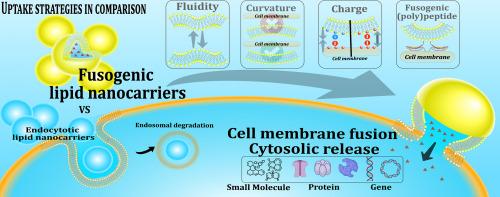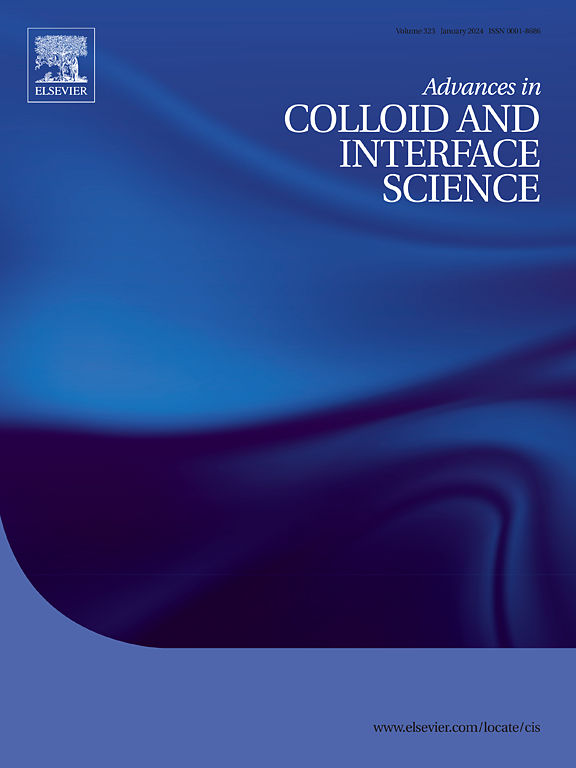促聚变脂质纳米载体:先进药物输送系统的自然启发设计
IF 19.3
1区 化学
Q1 CHEMISTRY, PHYSICAL
引用次数: 0
摘要
脂质纳米载体是一种有用的工具,用于细胞内递送药物,否则无法进入其靶细胞。大多数这些纳米载体是为内吞摄取而设计的,尽管这种细胞内药物递送途径有许多缺点。一个有希望的替代方案是融合性脂质纳米载体,因为通过这种摄取机制可以排除与内吞作用相关的溶酶体降解问题,并且药物释放到靶细胞可以与融合过程同步。生物融合事件的各种机制,包括受精、胞外分泌、病毒感染和质膜修复,都可以复制并转移到纳米载体上,使其能够与靶细胞融合。尤其是纳米载体的曲率、流动性和表面电荷是影响其致熔性能的关键参数。此外,脂质纳米载体可以用融合肽(如病毒融合肽或snare衍生的脂肽)修饰。在这篇综述中,我们提供了关于细胞膜融合过程的潜在机制的概述,我们展示了如何利用这些知识来设计融合性脂质纳米载体,并总结了融合性纳米载体在治疗不同疾病方面最有前途的应用。本文章由计算机程序翻译,如有差异,请以英文原文为准。

Fusogenic lipid nanocarriers: Nature-inspired design for advanced drug delivery systems
Lipid nanocarriers are a useful tool for intracellular delivery of drugs that are otherwise unable to enter their target cells. Most of these nanocarriers are designed for an endocytotic uptake, although this route of intracellular drug delivery has a number of shortcomings. A promising alternative is fusogenic lipid nanocarriers, since by this uptake mechanism lysosomal degradation problems being associated with endocytosis can be excluded and drug release into the target cell can be synchronized with the fusion process. Various mechanisms being responsible for biological fusion events, including fertilization, exocytosis, viral infection and plasma membrane repair can be copied and transferred to nanocarriers enabling them to fuse with target cells. In particular, curvature, fluidity and surface charge of nanocarriers are key parameters for fusogenic properties. Furthermore, lipid nanocarriers can be decorated with fusogenic (poly)peptides such as viral fusion peptides or SNARE-derived lipopeptides. Within this review we provide an overview about the underlying mechanisms being responsible for cell membrane fusion processes, we demonstrate how this knowledge can be utilized for the design of fusogenic lipid nanocarriers and we summarize most promising applications of fusogenic nanocarriers for treatment of different diseases.
求助全文
通过发布文献求助,成功后即可免费获取论文全文。
去求助
来源期刊
CiteScore
28.50
自引率
2.60%
发文量
175
审稿时长
31 days
期刊介绍:
"Advances in Colloid and Interface Science" is an international journal that focuses on experimental and theoretical developments in interfacial and colloidal phenomena. The journal covers a wide range of disciplines including biology, chemistry, physics, and technology.
The journal accepts review articles on any topic within the scope of colloid and interface science. These articles should provide an in-depth analysis of the subject matter, offering a critical review of the current state of the field. The author's informed opinion on the topic should also be included. The manuscript should compare and contrast ideas found in the reviewed literature and address the limitations of these ideas.
Typically, the articles published in this journal are written by recognized experts in the field.

 求助内容:
求助内容: 应助结果提醒方式:
应助结果提醒方式:


